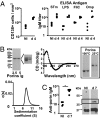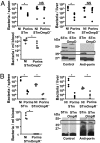The porin OmpD from nontyphoidal Salmonella is a key target for a protective B1b cell antibody response
- PMID: 19487686
- PMCID: PMC2701014
- DOI: 10.1073/pnas.0812431106
The porin OmpD from nontyphoidal Salmonella is a key target for a protective B1b cell antibody response
Abstract
Invasive nontyphoidal Salmonella (NTS), including Salmonella typhimurium (STm), are major yet poorly-recognized killers of infants in sub-Saharan Africa. Death in these children is usually associated with bacteremia, commonly in the absence of gastrointestinal symptoms. Evidence from humans and animal studies suggest that severe infection and bacteremia occur when specific Ab is lacking. Understanding how Ab responses to Salmonella are regulated will help develop vaccines against these devastating infections. STm induces atypical Ab responses characterized by prominent, accelerated, extrafollicular T-independent (TI) Ab against a range of surface antigens. These responses develop without concomitant germinal centers, which only appear as infection resolves. Here, we show STm rapidly induces a population of TI B220(+)CD5(-) B1b cells during infection and TI Ab from B1b cells targets the outer membrane protein (Omp) porins OmpC, OmpD and OmpF but not flagellin. When porins are used as immunogens they can ablate bacteremia and provide equivalent protection against STm as killed bacterial vaccine and this is wholly B cell-dependent. Furthermore Ab from porin-immunized chimeras, that have B1b cells, is sufficient to impair infection. Infecting with porin-deficient bacteria identifies OmpD, a protein absent from Salmonella Typhi, as a key target of Ab in these infections. This work broadens the recognized repertoire of TI protein antigens and highlights the importance of Ab from different B cell subsets in controlling STm infection. OmpD is a strong candidate vaccine target and may, in part, explain the lack of cross-protection between Salmonella Typhi and STm infections.
Conflict of interest statement
Conflict of interest statement: The results of this work have led to OmpD being patented as potential vaccine candidate against selected
Figures





References
-
- Gordon MA. Salmonella infections in immunocompromised adults. J Infect. 2008;56:413–422. - PubMed
-
- Graham SM, et al. Nontyphoidal Salmonella infections of children in tropical Africa. Pediatr Infect Dis J. 2000;19:1189–1196. - PubMed
-
- Mastroeni P, Menager N. Development of acquired immunity to Salmonella. J Med Microbiol. 2003;52:453–459. - PubMed
-
- Cunningham AF, et al. Salmonella induces a switched antibody response without germinal centers that impedes the extracellular spread of infection. J Immunol. 2007;178:6200–6207. - PubMed
-
- MacLennan C, et al. Interleukin (IL)-12 and IL-23 are key cytokines for immunity against Salmonella in humans. J Infect Dis. 2004;190:1755–1757. - PubMed
Publication types
MeSH terms
Substances
Grants and funding
LinkOut - more resources
Full Text Sources
Other Literature Sources
Molecular Biology Databases
Research Materials

